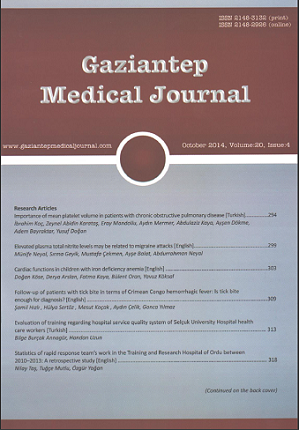Follow-up of patients with tick bite in terms of Crimean Congo hemorrhagic fever: Is tick bite enough for diagnosis?
Kene ısırığı olan hastalarin izlemi: Kırım Kongo gelişimi için ısırık yeterli mi?
DOI:
https://doi.org/10.5455/GMJ-30-161587Keywords:
Tick bite size, Crimean-Congo Hemorrhagic Fever, childrenAbstract
Crimean-Congo hemorrhagic fever (CCHF) is a multi-systemic tick born viral disease caused by a Nairovirus of the Family Bunyaviridae. Findings of disease are with fever, myalgia, chills, headache, vomiting and hemorrhagic manifestations. Infection is transmitted to humans by tick bite or by close contact with freshly slaughtered meat or blood from viremic animals. Since the tests of virus load consume much time, we preferred to study whether the findings obtained from anamnesis and physical exams of patients would be beneficial in predicting the clinical courses of patients. Files of 13 cases, who admitted to our clinic in the years 2006-2007 with the complaint of tick bite, were examined in this study. Anamnesis, physical and laboratory findings were recorded. Eleven of the cases were male. The age average was found to be 8.4 years (3-15). The period of first reference to our clinic was 3.4 days (1-8) on average. Bite size were 0.7 mm (0.4-1.4). The biggest bite was related to an adult tick. While serologic tests from the cases were found to be negative in twelve cases (92.3%), CCHF Immunoglobulin M taken on the third day was positive in one case (7.7%).This case was the one with biggest bite. In conclusion, the severity of the findings of CCHF is in correspondence with the size of virus load transferred. According to this study findings, size of tick and tick bite may be informative about the virus load and indirectly about the clinical outcome. Recording these findings for the future cases would be advised.
Metrics
References
Mostafavi E, Pourhossein B, Chinikar S. Clinical symptoms and laboratory findings supporting early diagnosis of Crimean-Congo hemorrhagic fever in Iran J Med Virol 2014;86(7):1188-92.
Ergonul O. Crimean-Congo haemorrhagic fever. Lancet Infect Dis 2006;6(4):203-14.
Gozalan A, Esen B, Fitzner J, Tapar FS, Ozkan AP, Georges- Courbot MC, et al. Crimean-Congo haemorrhagic fever cases in Turkey. Scand J Infect Dis 2007;39(4):332-36.
Karti SS, Odabasi Z, Korten V, Yilmaz M, Sonmez M, Caylan R, et al. Crimean-Congo hemorrhagic fever in Turkey. Emerg Infect Dis 2004;10(8):1379-84.
Whitehouse CA. Crimean-Congo hemorrhagic fever. Antiviral Res 2004;64(3):145-60.
Ahmed J, Alp H, Aksin M, Seitzer U. Current status of ticks in Asia. Parasitol Res 2007;101(Suppl 2):S159-62.
Papa A, Bino S, Liagami A, Brahimaj S, Papadimitriou E, Pavlidou V, et al. Crimean-Congo hemorrhagic fever in Albenia, 2001. Eur J Clin Microbiol Infect Dis 2002;21(8):603-6.
Vorou R, Pierroutsakos IN, Maltezou HC. Crimean-Congo hemorrhagic fever. Curr Opin Infect Dis 2007;20(5):495– 500.
Cevik MA, Erbay A, Bodur H, Eren SS, Akinci E, Sener K, et al. Viral load as a predictor of outcome in Crimean-Congo hemorrhagic fever. Clin Infect Dis 2007;45(7):e96-100.
Duh D, Saksida A, Petrovec M, Ahmeti S, Dedushaj I, Panning M, et al. Viral load as predictor of Crimean-Congo hemorrhagic fever outcome. Emerg Infect Dis 2007;13(11):1769-72.
Downloads
Published
How to Cite
Issue
Section
License
Copyright (c) 2023 European Journal of Therapeutics

This work is licensed under a Creative Commons Attribution-NonCommercial 4.0 International License.
The content of this journal is licensed under a Creative Commons Attribution-NonCommercial 4.0 International License.


















